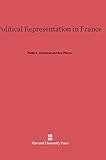Political Representation in France / Philip E. Converse, Roy Pierce.
Material type: TextPublisher: Cambridge, MA : Harvard University Press, [2013]Copyright date: ©1986Edition: Reprint 2014Description: 1 online resource (996 p.) : illustrationsContent type:
TextPublisher: Cambridge, MA : Harvard University Press, [2013]Copyright date: ©1986Edition: Reprint 2014Description: 1 online resource (996 p.) : illustrationsContent type: - 9780674187870
- 9780674187887
- Elections
- Political science
- Politik
- Repräsentative Demokratie
- Voting registers
- Elections -- France -- Longitudinal studies
- France -- Politics and government -- 1958-
- France. Parlement (1946- ). -- Assemblée nationale -- Elections -- Longitudinal studies
- POLITICAL SCIENCE / General
- Voting -- France -- Longitudinal studies
- HISTORY / General
- 324.944
- JN2959 -- C668 1986eb
- online - DeGruyter
| Item type | Current library | Call number | URL | Status | Notes | Barcode | |
|---|---|---|---|---|---|---|---|
 eBook
eBook
|
Biblioteca "Angelicum" Pont. Univ. S.Tommaso d'Aquino Nuvola online | online - DeGruyter (Browse shelf(Opens below)) | Online access | Not for loan (Accesso limitato) | Accesso per gli utenti autorizzati / Access for authorized users | (dgr)9780674187887 |
Frontmatter -- Contents -- Preface -- Introduction -- PART I. The French Voter -- 1. The Framework of French Politics -- 2. French Voters and Their Party System -- 3. Party Loyalties in France -- 4. La Gauche et la Droite -- 5. Class, Religion, and Gaullism -- PART II. Choosing a Representative -- 6. The Candidates -- 7. Policy Attitudes of Mass and Elite -- 8. Candidate Visibility -- 9. Issues, Parties, and Candidates -- 10. The First-Ballot Vote -- 11. The Second Ballot: Electoral Participation -- 12. The Second Ballot: The Flow of the Vote -- 13. The Second Ballot: Candidate Behavior and Electoral Response -- PART III. The System in Crisis -- 14. Revolt and Reaction: The Upheaval of May 1968 and the June Elections -- 15. Elite Reactions to The May-June Events -- PART IV. The Representation System -- 16. Theories and Models of Representation -- 17. The Deputies in the National Assembly -- 18. The Basic Representation Bond -- 19. Winners, Losers, and Their Constituencies -- 20. Elite Knowledge of Constituency Sentiment -- 21. Conceptions of the Representative Role -- 22. The Composite Representation Process -- 23. Conditional Variations in Representation -- 24. The Nature of Representation in France -- Appendices. Notes. Bibliography. Index -- APPENDIX A. Design and Implementation of the Mass Interviewing -- APPENDIX B. The Structure of the Elite Sample -- APPENDIX C. Correction of Correlations for Small-Sample Attenuation -- APPENDIX D. Questionnaires -- Notes -- Bibliography -- Index
restricted access online access with authorization star
http://purl.org/coar/access_right/c_16ec
There can scarcely be a greater tribute to the vitality of the Fifth Republic's democracy than this monumental work. A searching analysis of how the will of the voters is translated into authoritative political decision making, this book not only uncovers political truths about contemporary France but also provides a model for the study of other popular forms of government. The authors set out to find an answer to the perplexing question of how representative government operates in France in the seemingly unstable context of multiparties. By interviewing voters as well as legislators in 1967 and in 1968 after the great upheaval, and by monitoring policies of the National Assembly from 1967 to 1973, the authors test relationships between public opinion and decision making. They are able to sort out the abiding political cues that orient the French voter, to establish the normal electoral processes, to gauge the nature of mass perceptions of the political options available to voters, and to interpret the strikes, riots, and demonstrations of 1968 as a channel of communication parallel to the electoral process itself. Lucid in style, methodologically sophisticated, and often comparative in approach, Political Representation in France is a seminal work for political scientists, sociologists, and historians.
Mode of access: Internet via World Wide Web.
In English.
Description based on online resource; title from PDF title page (publisher's Web site, viewed 24. Aug 2021)


